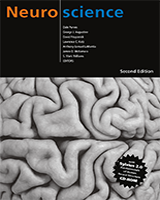By agreement with the publisher, this book is accessible by the search feature, but cannot be browsed.
NCBI Bookshelf. A service of the National Library of Medicine, National Institutes of Health.
Purves D, Augustine GJ, Fitzpatrick D, et al., editors. Neuroscience. 2nd edition. Sunderland (MA): Sinauer Associates; 2001.

Neuroscience. 2nd edition.
Show detailsThe normal cycle of sleep and wakefulness implies that, at specific times, various neural systems are being activated while others are being turned off. A key to the neurobiology of sleep is therefore to understand the various stages of sleep. For centuries—indeed up until the 1950s—most people who thought about sleep considered it a unitary phenomenon whose physiology was essentially passive and whose purpose was simply restorative. In 1953, however, Nathaniel Kleitman and Eugene Aserinksy showed, by means of electroencephalographic (EEG) recordings from normal subjects, that sleep actually comprises different stages that occur in a characteristic sequence (Figures 28.5 and 28.6).

Figure 28.5
EEG recordings during the first hour of sleep. The waking state with the eyes open is characterized by high-frequency (15–60 Hz), low-amplitude activity (~30 μV) activity. This pattern is called beta activity. Descent into stage I non-REM (more...)

Figure 28.6
Physiological changes in a male volunteer during the various sleep states in a typical 8-hour period of sleep (A). The duration of REM sleep increases from 10 minutes in the first cycle to up to 50 minutes in the final cycle; note that slow-wave (stage (more...)
Humans descend into sleep in stages that succeed each other over the first hour or so after retiring (Figure 28.5). These characteristic stages are defined primarily by electroencephalographic criteria (Box C). Initially, during “drowsiness,” the frequency spectrum of the electroencephalogram (EEG) is shifted toward lower values and the amplitude of the cortical waves slightly increases. This drowsy period, called stage I sleep, eventually gives way to light or stage II sleep, which is characterized by a further decrease in the frequency of the EEG waves and an increase in their amplitude, together with intermittent high-frequency spike clusters called sleep spindles. Sleep spindles are periodic bursts of activity at about 10–12 Hz that generally last 1 or 2 seconds and arise as a result of interactions between thalamic and cortical neurons. In stage III sleep, which represents moderate to deep sleep, the number of spindles decreases, whereas the amplitude of low-frequency waves increases still more. In the deepest level of sleep, stage IV sleep, the predominant EEG activity consists of low frequency (1–4 Hz), high-amplitude fluctuations called delta waves, the characteristic slow waves for which this phase of sleep is named. The entire sequence from drowsiness to deep stage IV sleep usually takes about an hour.
Box C
Electroencephalography.
These four sleep stages are called non-rapid eye movement (non-REM) sleep, and its most prominent feature is the slow-wave (stage IV) sleep. It is most difficult to awaken people from slow-wave sleep; hence it is considered to be the deepest stage of sleep. Following a period of slow-wave sleep, however, EEG recordings show that the stages of sleep reverse to reach a quite different state called rapid eye movement, or REM, sleep. In REM sleep, the EEG recordings are remarkably similar to that of the awake state (see Figure 28.5). After about 10 minutes in REM sleep, the brain typically cycles back through the non-REM sleep stages. Slow-wave sleep usually occurs again in the second period of this continual cycling, but not during the rest of the night (see Figure 28.6). On average, four additional periods of REM sleep occur, each having longer durations.
In summary, the typical 8 hours of sleep experienced each night actually comprise several cycles that alternate between non-REM and REM sleep, the brain being quite active during much of this supposedly dormant, restful time. For reasons that are not clear, the amount of REM sleep each day decreases from about 8 hours at birth to 2 hours at 20 years to only about 45 minutes at 70 years of age.
- PubMedLinks to PubMed
- Stages of Sleep - NeuroscienceStages of Sleep - Neuroscience
Your browsing activity is empty.
Activity recording is turned off.
See more...